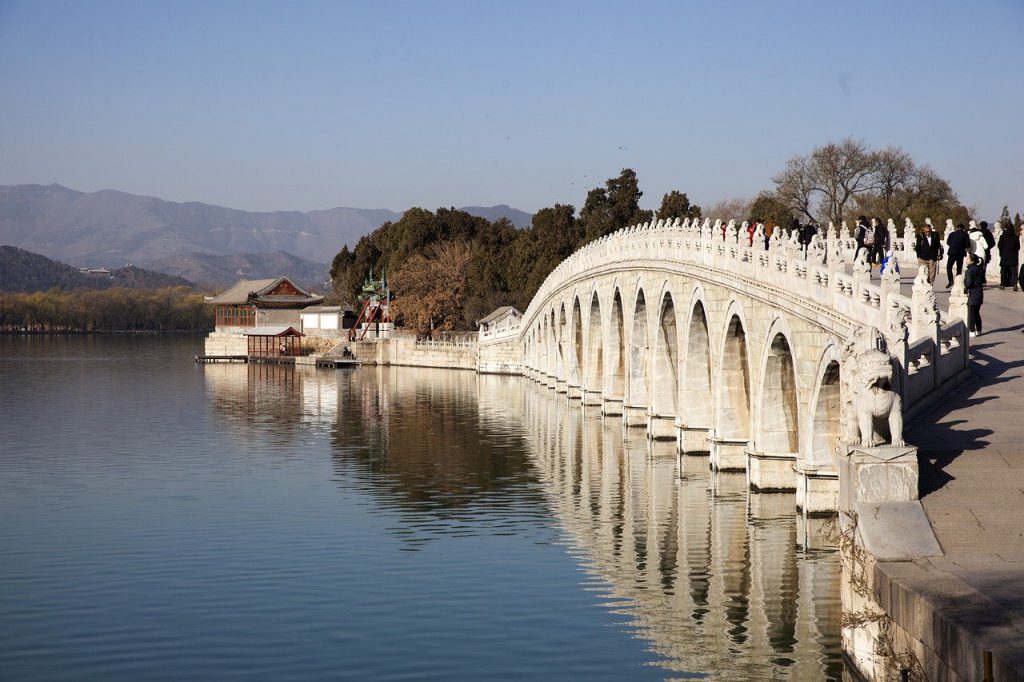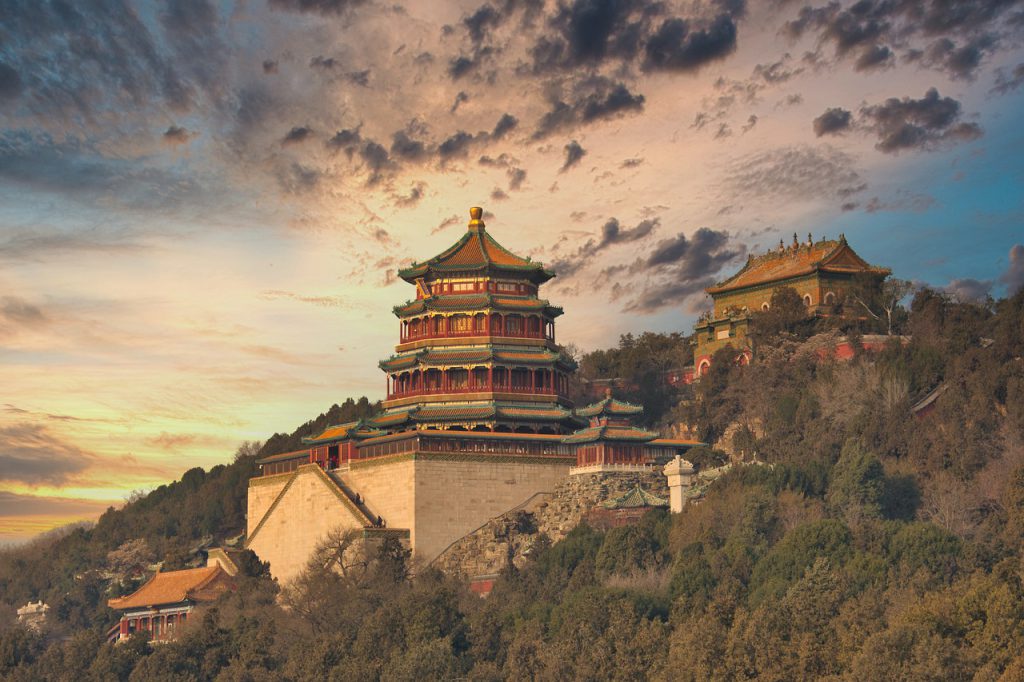When Was the Summer Palace Built in China?
Before Emperor Qianlong of the Qing Dynasty succeeded to the throne, four large royal gardens were built in the western suburbs of Beijing.
In the fifteenth year of Qianlong (1750), Emperor Qianlong used 4.48 million silver to honor his mother, the Queen of the Holy Constitution, to transform it into the Garden of clear ripples, forming a 20-kilometer-long royal garden from Tsinghua Garden to Xiangshan.
In the tenth year of Xianfeng (1860), the Garden of clear ripples was burned by the Anglo-French coalition forces.
Guang Xu 14 years (1888) reconstruction, renamed the Summer Palace, as a summer resort.
In the 26 year of Guang Xu (1900), the Summer Palace was destroyed by the “allied forces of the eight powers” and the treasures were looted.
After the fall of the Qing Dynasty, the Summer Palace was destroyed again during the period of infighting among warlords and Kuomintang rule.
The Summer Palace consists of two major parts, Wanshou Hill and Kunming Lake, with beautiful scenery and magnificent architecture. The park has more than 3000 buildings of all kinds, and the layout of the park can be divided into three areas: politics, life and tourism. The political activity area, centered on the Renshou section, was the place where Empress Dowager Cixi and Emperor Guang Xu used to handle affairs and meet courtiers and envoys. The living area, with Yulan Hall, Yiyun Hall and Leshou Hall as the main body, is the place where Cixi, Guang Xu and the imperial concubine live. Scenic spots, mainly in front of Longevity Hill, back Mountain, back Lake and Kunming Lake, are the main components of the whole park.
Who Was the Founder of the Summer Palace?

It was built in 1750 by Qianlong to celebrate his mother’s 60th birthday.
In 1750, in order to celebrate his mother’s 60th birthday, Qianlong changed the name of the mountain to “Wanshou Hill” and built the “Da Bao En Yan Shou Temple” on the basis of Yuanjing Temple in the Ming Dynasty.
The Summer Palace is the royal garden and palace of the Qing Dynasty, formerly known as the Garden of clear ripples. The Summer Palace is the last garden built in the three mountains and five gardens. It was built in 1750 and completed in 1764, covering an area of 290ha (4400 mu), accounting for about 3/4 of the water surface.
Before Qianlong succeeded to the throne, four large royal gardens had been built in the western suburbs of Beijing. the four gardens from Haidian to Xiangshan formed their own system and lacked organic connection with each other, and the “Wengshan Park” in the middle became an open area. Qianlong decided to use a huge amount of silver to build the Garden of clear ripples in the area of Wengshan, taking this as the center to connect the four gardens on both sides into one.
It has formed a royal garden area with a length of 20 kilometers from Tsinghua Garden to Xiangshan.
The History of the Summer Palace
In the seventh year of Hongzhi in the Ming Dynasty, Ming Xiaozong’s nurse Luo built Yuanjing Temple in front of Wengshan, which was later abandoned.
Since then, the number of gardens around Wengshan has gradually increased.
Ming Wuzong built a palace on the lakeside, which is called “Haoshan Garden” and is a royal garden.
Ming Wuzong and Ming Shenzong used to go boating here.
During the reign of Ming Xi, Wei Zhongxian took the Haoshan Garden as his own.
In the early years of Empress Dowager Qianlong of the Qing Dynasty, in order to prepare for the 60th birthday of Empress Dowager Chongde, Emperor Qianlong ordered the excavation of the West Lake under the pretext of harnessing the Jingxi water system to ensure water for the palace gardens and provide irrigation water for the surrounding farmland.
Emperor Qianlong renamed the West Lake to Kunming Lake, built the earthwork of the lake on Wengshan to the north of Kunming Lake, and renamed Wengshan to Wanshou Hill.
In 29 years, Qianlong built the Garden of clear ripples, which consumed more than 4.8 million taels of silver.
The main building in the park is Da Bao en Yanshou Temple, and there is a long corridor with a length of more than 700 meters.
There are very few administrative and residential buildings in the Garden of clear ripples in the Longevity Hill of the Summer Palace. Emperor Qianlong visited the Garden of clear ripples on the same day and never lived in the garden.
After Daoguang years of the Qing Dynasty, due to the weakness of national strength, it was announced that the furnishings of the three mountains would be withdrawn, and the Garden of clear ripples was gradually abandoned.
Due to the limited funds, the financial resources were concentrated to restore the Qianshan building complex, and a fence was built around Kunming Lake, renamed the Summer Palace, and became a departure from the palace.
The architecture and cultural relics in the garden of Guang Xu were destroyed by the allied forces of the eight powers in 26 and restored by Guang Xu in 28 (1902).
Although the Summer Palace has generally restored the landscape of the Garden of clear ripples, many of its quality has declined.
As Cixi prefers Suzhou-style color paintings, the color paintings of many houses in pavilions and galleries have also changed from Heyi color paintings to Suzhou-style color paintings, changing the original appearance of the Garden of clear ripples in detail.
A Brief Introduction to the History of the Summer Palace
The Summer Palace, the ancient royal garden in Beijing, formerly known as the Garden of clear ripples, is located in the western suburbs of Beijing, 15 kilometers away from the urban area, covering an area of about 290 hectares, adjacent to Old Summer Palace.
It is a large-scale landscape garden based on Kunming Lake and Longevity Hill, based on the West Lake in Hangzhou and drawing on the design techniques of the gardens in the south of the Yangtze River. it is also the most well-preserved royal palace, known as the “Royal Garden Museum”. It is also a national key tourist attraction.
Before Emperor Qianlong of the Qing Dynasty succeeded to the throne, four large royal gardens were built in the western suburbs of Beijing.
In the fifteenth year of Emperor Qianlong (1750), Emperor Qianlong used 4.48 million silver to honor his mother and the holy queen to transform it into the Garden of clear ripples, forming a 20-kilometer-long royal garden from Tsinghua Garden to Xiangshan.
In the tenth year of Xianfeng (1860), the Garden of clear ripples was burned by the Anglo-French coalition forces.
Guang Xu 14 years (1888) reconstruction, renamed the Summer Palace, as a summer resort.
In the 26 year of Guang Xu (1900), the Summer Palace was destroyed by the “allied forces of the eight powers” and the treasures were looted.
After the fall of the Qing Dynasty, the Summer Palace was destroyed again during the period of infighting among warlords and Kuomintang rule.
On March 4, 1961, the Summer Palace was announced as the first batch of national key cultural relic protection units, together with Chengde Summer Resort, Humble Administration Garden and Liuyuan announced at the same time as the four famous gardens in China, and was listed on the World Heritage list in November 1998.
On May 8, 2007, the Summer Palace was officially approved by the National Tourism Administration as a national 5A-level tourist attraction.
In 2009, the Summer Palace was selected by the China World Records Association as the largest existing royal garden in China.
A Historical Introduction to the Promenade of the Summer Palace in Beijing
The structures of corridors in Chinese gardens are commonly used: wooden structure, masonry structure, steel and concrete structure, bamboo structure and so on.
The top of the corridor has a slope top, a flat roof, a vault and so on.
The forms and design techniques of corridors in Chinese gardens are rich and varied.
According to the structural form, the basic types can be divided into five types: double-sided empty corridor, single-sided empty corridor, double-sided corridor, double-sided corridor and single colonnade.
According to the overall shape of the corridor and its relationship with topography and environment, it can be divided into: straight corridor, curved corridor, corridor, hand-copying corridor, mountain climbing corridor, overlapping corridor, water corridor, bridge corridor and so on.
Double-Sided Empty Gallery
There are columns on both sides, and there are no solid walls, so you can enjoy two views in the corridor.
The double-sided empty corridor can be used no matter the straight corridor, curved corridor, corridor, copying gallery, etc., no matter in the large space with far-reaching scenery, or in the small space with twists and turns and dexterity.
The long corridor in the Summer Palace in Beijing is a double-sided empty corridor with a total length of 728 meters, with Wanshou Hill in the north and Kunming Lake in the south, piercing flowers and trees, connecting more than a dozen groups of buildings in front of Wanshou Hill and playing a prominent role in enriching the landscape.
Single-Sided Empty Gallery
There are two kinds: one is to build a solid wall or semi-solid wall between the columns on one side of the double-sided corridor, and the other is completely attached to the wall or the edge of the building.
The roof of a single-sided empty corridor is sometimes made into a single slope to facilitate drainage.
The promenade is one of the most important scenic spots in the Summer Palace, and it is also the only way to the main scenic spots in the central area of the park.
Visitors travel westward from the starting point of the eastern end of the corridor, “invitation Moon Gate”. Along the north side of the corridor, there are three ancient bridges worth seeing.
The first is the “three-hole dry Bridge”.
The bridge was built during the period from Qianlong to Guang Xu.
The exact time of construction of the bridge is unknown.
Among the historical materials of the Summer Palace, only Guang Xu’s “Plan of the Summer Palace” has marked the bridge, but there are no other written records and no name.
Mr. Liang Xinli called it “three-hole dry Bridge” in his book “Beijing Ancient Bridge”.
Because the bridge was built on flat ground.
There is no river under the bridge.
The function of the bridge is that when heavy rain and torrential rain come, Rain Water on Wanshou Hill passes through the three huge holes of the bridge to divert and drain into Kunming Lake.
It is a spillway bridge.
The bridge is built on a hillside.
Connect Yangyunxuan in the west and Yangren wind rockery in the east.
Visitors can travel between the two courtyards through this bridge.
Under the bridge is also a narrow passage leading to the mountain.
How Long Does It Take to Visit the Summer Palace and Old Summer Palace?
How long does it take to visit the Summer Palace and Old Summer Palace? it depends on how you visit.
There are more than 3000 ancient buildings in the Summer Palace, covering an area of more than 70000 square meters. the well-known representative buildings are Foxiang Pavilion, Promenade, Shifang, Suzhou Street, Seventeen Kong Bridge, Harmony Garden, Grand stage, and so on. It only takes half a day for a tour, and it will take a day to listen to the tour guide and taste the royal garden style.
Old Summer Palace, on the other hand, only needs 2-3 hours, because what is inside has been left in ruins by the scourge of the Western powers, and there is nothing to see. It is only used to warn the Chinese people that “the weak country has been bullied by others,” so as to avoid repeating the same mistake.










